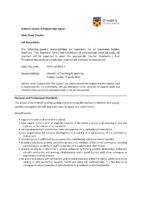Introduction
A few months ago, our school embarked on a journey that has transformed both our outdoor space and our community. We decided to set up a school garden—a space where students, teachers, and in the future, the local community could come together to learn, grow, and connect with nature, primarily to support positive mental health.
The Vision
The idea for the garden came from the evidence-based research that was published in April 2021 by RHS scientists Professor Alistair Griffiths and Dr Lauriane Chalmin-Pui that proves how gardening benefits our mental, physical and social wellbeing.
Our garden is inspired by ‘The Vitamin G’ garden that exhibited in the RHS Hampton Court Palace Garden Festival in 2022 which provided visitors with a daily dose of ‘vitamin G’.
Our space would be somewhere that students could learn about nature and how it could support their wellbeing. It would also provide an opportunity for students to develop a sense of responsibility and care for their environment.
Our idea was submitted to The Borough of Broxbourne and was then only possible due to their generous funding.
Planning and Preparation
Creating the garden was a collaborative effort from the start. Students were asked to design a garden space that they wanted to see and use as part of their school. We were inundated with ideas and these contributed to the planning phase. We selected a sunny spot on the school field that was underutilised, transforming it from a patch of grass into a vibrant garden space. We divided the area into two, one for an allotment with raised beds, shed and greenhouse and the other with sensory planting and benches.
Using the funding we were awarded we stocked the shed with the necessary tools and bought a variety of plants and seeds ready to sow.
The Planting
We took a ‘no dig’ approach to setting up the garden, which meant avoiding breaking up, lifting or turning the soil, leaving the soil undisturbed as much as is practical. This technique recognises that micro- and macro-biotic organisms constitute a ‘food web’ community in the soil, necessary for the healthy cycling of nutrients and prevention of problematic organisms and diseases. We achieved this by placing layers of cardboard on the grass and then putting the compost on top. Once the garden beds were ready, the real fun began. Two lunchtime clubs were set up for students which ran weekly. Once the seeds had started growing following their first few weeks in the greenhouse, we were able to plant them straight into the compost in our raised beds. Students were excited to get their hands dirty, planting seeds and seedlings while learning about the life cycle of plants. Students got involved with recycling and sustainability by using the compost bins and collecting water from the rainwater collection system and water butt.
It wasn’t just about planting, though. The garden became a space where students could learn about teamwork and responsibility. They took turns watering the plants, weeding the beds, and monitoring the growth of their crops.
“The club is a fun and relaxing place to plant and chill with friends at lunchtime” commented one student.
Growth and Learning
As the garden grew, so did our students. They learnt about the importance of patience and perseverance, as some crops took more time than others. They also learnt about failure and resilience when some plants didn’t thrive, and how to adapt and try again.
The garden also served as a powerful tool for teaching about sustainability as well as the importance of biodiversity. They saw first-hand how organic gardening practices can help protect the environment and now some of the students have been inspired to grow plants in their gardens.
Harvesting
Harvest time was a celebration in itself. The work students put in was greatly rewarded with giant fruit and vegetables that they enjoyed taking home and sharing with their families.
One student remarked “I was lucky enough to take home one of the largest courgettes I have ever seen to make my mum and dad a nice meal…!”
We also gave some of our produce to Caterlink, who provide the school meals. It then appeared on the lunch menu as a vegetarian main option, which proved very popular.
It was a delicious way to connect the dots between growing food and eating healthy.
Looking Ahead
Our school garden is still young, but it has already become an integral part of our school culture. We’re excited to see how the garden continues to grow—both in terms of the plants and the learning opportunities it provides. It’s a project that will continue to evolve, just like our students.
The creation of our school garden has been a rewarding experience for everyone involved. It’s more than just a place to grow plants; it’s a place to grow minds, friendships, and a deeper appreciation for the world around us. As our garden flourishes, so too does our community.
You can find out what the future holds in the next blog by our ‘Garden Guardians’.





